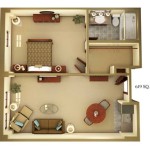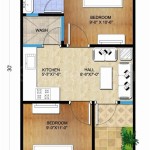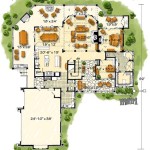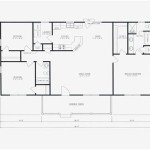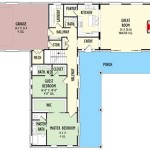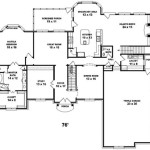Small One-Story Retirement House Plans: Maximizing Comfort and Accessibility
Retirement often marks a significant shift in lifestyle, prompting individuals to re-evaluate their housing needs. For many, the prospect of downsizing from a larger family home to a smaller, more manageable residence becomes increasingly appealing. Small one-story retirement house plans present a compelling option for those seeking comfort, accessibility, and reduced maintenance in their golden years. These plans prioritize efficient space utilization, aging-in-place design principles, and streamlined living, allowing retirees to focus on enjoying their newfound freedom and pursuing their passions.
When considering small one-story retirement house plans, it's crucial to acknowledge that "small" is a relative term. The ideal size will vary depending on individual needs, lifestyle preferences, and financial considerations. Generally, plans ranging from 800 to 1500 square feet are considered small and well-suited for retirees. This square footage can accommodate essential living spaces, including a comfortable living area, a functional kitchen, one or two bedrooms, a bathroom, and potentially a small office or hobby space. The key lies in optimizing the layout to maximize functionality and minimize wasted space.
The appeal of a single-story home is particularly strong for retirees due to the absence of stairs. This feature directly addresses mobility concerns that may arise with age, making the home safer and more accessible. Beyond the elimination of stairs, thoughtful design considerations can further enhance accessibility throughout the house. This includes wider doorways and hallways to accommodate wheelchairs or walkers, lever-handled door hardware for easier operation, and strategically placed grab bars in bathrooms.
Key Point 1: Prioritizing Accessibility and Aging-in-Place Features
Accessibility is paramount when designing a retirement home. The integration of aging-in-place features ensures that the home remains comfortable and functional for years to come, even as mobility needs change. This involves proactive planning to anticipate potential challenges and incorporate solutions that promote independence and safety.
Bathrooms are a critical area to focus on when addressing accessibility. Walk-in showers with low thresholds, built-in seating, and adjustable showerheads offer a safer and more convenient bathing experience. Taller toilets with comfort-height seating are also easier to use. Reinforced walls around the toilet and shower allow for the future installation of grab bars if needed. Non-slip flooring is essential to prevent falls.
In the kitchen, adjustable countertops and pull-down shelves can accommodate individuals with varying physical abilities. Front-mounted controls on appliances are easier to reach and operate. Adequate lighting is crucial throughout the home to improve visibility and reduce the risk of falls. Consider installing task lighting in the kitchen and bathrooms, as well as nightlights in hallways and bedrooms.
Beyond specific fixtures and features, the overall layout of the home should be designed with accessibility in mind. An open floor plan promotes ease of movement and reduces the potential for tripping hazards. Clear pathways throughout the house are essential, and clutter should be minimized to maintain a safe and navigable environment. A zero-step entry eliminates the need for steps at the front door, making it easier to enter and exit the home. Consider incorporating automatic door openers for added convenience.
Smart home technology can also play a significant role in enhancing accessibility and independence. Voice-activated lighting, temperature control, and security systems can be particularly beneficial for individuals with limited mobility. Remote monitoring systems can provide peace of mind for both residents and their families.
Key Point 2: Maximizing Space and Functionality in a Smaller Footprint
Effective space planning is essential when designing a small one-story retirement home. The goal is to create a living environment that feels spacious and comfortable, despite its smaller size. This requires careful consideration of furniture placement, storage solutions, and the overall flow of the layout.
Open floor plans are particularly well-suited for small homes, as they create a sense of spaciousness by eliminating walls between living areas. This allows natural light to flow freely throughout the home, making it feel brighter and more inviting. A combined living, dining, and kitchen area can create a central hub for social interaction and daily activities.
Multipurpose furniture is another key strategy for maximizing space. Sofa beds can provide extra sleeping space for guests, while coffee tables with hidden storage can help keep clutter at bay. Built-in shelving and cabinetry can maximize storage potential without taking up valuable floor space. Consider incorporating a breakfast bar or island in the kitchen to provide additional counter space and seating.
Vertical space should also be utilized effectively. Tall cabinets and shelves can provide ample storage without encroaching on floor space. Consider installing crown molding to draw the eye upward and create a sense of height. Mirrors can also be used to create the illusion of more space.
Outdoor living spaces can effectively extend the living area of a small home. A patio or deck provides a place to relax and entertain outdoors. Screened porches can offer protection from insects and the elements, allowing residents to enjoy the outdoors year-round. Low-maintenance landscaping can further enhance the appeal of the outdoor space.
Careful consideration should be given to the placement of windows and doors. Large windows can bring in natural light and create a connection to the outdoors. Sliding glass doors are a space-saving alternative to swinging doors. Skylights can also be used to brighten interior spaces.
Key Point 3: Focusing on Low Maintenance and Energy Efficiency
Retirement is a time to relax and enjoy life, not to be burdened by home maintenance. Choosing low-maintenance materials and incorporating energy-efficient features can significantly reduce the workload and expenses associated with homeownership.
Selecting durable and low-maintenance exterior materials is crucial. Vinyl siding, brick, and fiber cement siding are all excellent options that require minimal upkeep. A metal roof can last for decades and requires little maintenance. Consider using composite decking for patios and decks, as it is resistant to rot and insect damage.
Inside the home, choose flooring materials that are easy to clean and maintain. Hardwood floors are durable and aesthetically pleasing, but they require regular maintenance. Tile and vinyl flooring are more resistant to scratches and stains. Consider using area rugs to add warmth and comfort to hard floors.
Energy efficiency is another important consideration. Insulating the home properly can significantly reduce heating and cooling costs. Energy-efficient windows and doors can also help to minimize energy loss. Consider installing a high-efficiency HVAC system to further reduce energy consumption. Solar panels can provide a renewable source of energy and reduce reliance on the grid. Programmable thermostats allow for automated temperature adjustments, reducing energy waste when the home is unoccupied.
Landscaping should also be designed with low maintenance in mind. Choose drought-tolerant plants that require minimal watering. Consider using mulch to suppress weeds and retain moisture. Artificial turf can provide a low-maintenance alternative to natural grass.
Regular maintenance should be scheduled to prevent small problems from becoming major repairs. This includes tasks such as cleaning gutters, inspecting the roof, and servicing the HVAC system. Consider hiring a handyman or contractor to handle these tasks if you are unable to do them yourself.
In addition to these design considerations, careful planning and budgeting are essential for a successful small one-story retirement home project. Working with an experienced architect or builder who understands the unique needs of retirees can help ensure that the home meets your specific requirements and budget. A well-designed small one-story retirement home can provide a comfortable, accessible, and low-maintenance living environment that allows you to enjoy your retirement years to the fullest.

Small One Story 2 Bedroom Retirement House Plans Houseplans Blog Com

Small One Story 2 Bedroom Retirement House Plans Houseplans Blog Com

Small One Story 2 Bedroom Retirement House Plans Houseplans Blog Com

Small One Story 2 Bedroom Retirement House Plans Houseplans Blog Com

Small One Story 2 Bedroom Retirement House Plans Houseplans Blog Com

Small One Story 2 Bedroom Retirement House Plans Houseplans Blog Com

10 Small House Plans With Open Floor Blog Homeplans Com

Best One Story House Plans And Ranch Style Designs
:max_bytes(150000):strip_icc()/sparta_0_0_0-d60217d2c379489398f52916b81e268c.jpg?strip=all)
40 Small House Plans That Are Just The Right Size

10 Small House Plans With Open Floor Blog Homeplans Com

